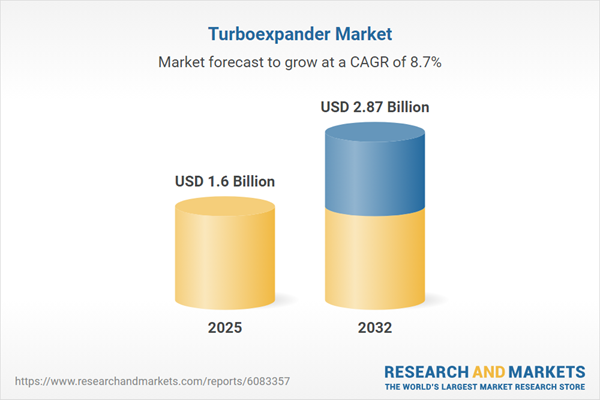Speak directly to the analyst to clarify any post sales queries you may have.
The turboexpander market is emerging as a focal point in industrial modernization, as energy producers and process industries adopt advanced solutions for efficiency, reliability, and sustainability. Turboexpanders are integral to driving operational improvements and supporting environmental targets within complex energy and gas processing value chains.
Turboexpander Market Snapshot
The turboexpander market demonstrates robust growth, guided by surging demand for efficient gas processing and sustainable petrochemical operations. Market expansion is closely linked to ongoing technological developments in turbine durability and digitalized process control, along with stricter regulatory standards worldwide. Investment momentum is observed in modern compressor system upgrades, integration of hybrid energy systems, and redevelopment of existing industrial infrastructure. As organizations seek to improve reliability and environmental performance, the uptake of turboexpander technology is becoming increasingly pronounced across various regions and industrial applications.
Scope & Segmentation of the Turboexpander Market
This report delivers strategic insights into the turboexpander landscape, analyzing adoption drivers and sector developments across key segments and geographies:
- Application Areas: Turboexpanders are essential in liquefied natural gas (LNG) production, gas processing plants, natural gas liquids (NGL) recovery, petrochemical processes, and petroleum refineries. These applications range from high to low-flow operations, ensuring energy conversion is optimized for varied industrial requirements.
- Capacity Segments: Coverage includes units under five megawatts, intermediate systems between five and fifteen megawatts, and larger installations above fifteen megawatts. This segmentation enables tailored solutions for diverse operational scales and project scopes.
- Expander Types: Both multi-stage and single-stage turboexpanders are featured. The technology choice is shaped by efficiency targets, space constraints, and ease of maintenance for seamless integration into new builds and retrofit projects.
- End User Industries: Core industries benefitting from turboexpander integration include the chemical sector, petrochemicals (covering ammonia, urea, ethylene, and methanol production), energy suppliers, power generation, and the full oil and gas lifecycle—from upstream through downstream activities.
- Regional Coverage: The report provides insights on regional performance and trends for the Americas (covering North and Latin America), Europe, the Middle East and Africa, and Asia-Pacific. Focus markets such as the United States, China, Germany, and Saudi Arabia are analyzed for their particular influence and unique adoption patterns.
- Key Market Participants: Strategies, innovations, and expansion activities of major players are reviewed, including Elliott Group, Atlas Copco AB, Baker Hughes, Siemens Energy, General Electric, MAN Energy Solutions, Linde plc, TechnipFMC, Mitsubishi Heavy Industries, and Chart Industries.
Key Takeaways for Energy and Industrial Leaders
- Advanced materials like nickel-based superalloys and ceramic coatings have extended turboexpander resilience to high-temperature, high-stress environments, supporting longer asset lifespans.
- Digital twin implementation and predictive analytics shift asset management towards prevention, enhancing facility uptime and optimizing maintenance expenditure.
- Organizations are realigning supply chains, focusing on localized sourcing and supplier diversification to address emerging global trade and regulatory shifts.
- Modular turboexpander systems now allow organizations to deploy installations rapidly and flexibly, meeting evolving project requirements efficiently.
- Sustainability-linked investment frameworks are increasingly promoting turboexpander deployment on new sites, enhancing the sector’s momentum toward emissions reduction.
- Integrated solutions developed through manufacturer-service provider collaboration strengthen lifecycle support and simplify end-to-end project execution.
Impact of United States Tariff Policies on the Turboexpander Market
Adjustments to United States tariff regulations are impacting sourcing and supply strategies for turboexpander components. Original equipment manufacturers and operators are prioritizing reshoring procurement and broadening supplier networks to mitigate both regulatory and supply-related risks. These changes may temporarily raise up-front capital needs but encourage greater consistency in supply, improved quality control, and reduced dependence on unstable international logistics.
Methodology & Data Sources
This analysis is based on primary research, in-depth expert interviews, and focused workshops. Key findings are validated through review of published market studies, academic materials, patent databases, and financial disclosures. Each data set is cross-examined by industry authorities to ensure strategic reliability and actionable value.
Why This Turboexpander Market Report Matters
- Enables executives to make informed capital allocation, technology adoption, and risk mitigation decisions in the context of rapid industry change.
- Provides comprehensive segmentation and trend guidance, which is vital for effective business planning, competitive benchmarking, and regional go-to-market strategies.
- Clarifies the effects of policy and innovation cycles, giving clear context as teams navigate evolving regulatory requirements and shifting market dynamics.
Conclusion
With this report, decision-makers can navigate the turboexpander landscape confidently, equipping their organizations to evaluate, adopt, and optimize solutions for stronger results. Adapting to ongoing industry transformation remains essential for maintaining long-term operational resilience and sustainability.
Table of Contents
3. Executive Summary
4. Market Overview
7. Cumulative Impact of Artificial Intelligence 2025
Companies Mentioned
The companies profiled in this Turboexpander market report include:- Elliott Group
- Atlas Copco AB
- Baker Hughes Company
- Siemens Energy AG
- General Electric Company
- MAN Energy Solutions SE
- Linde PLC
- TechnipFMC PLC
- Mitsubishi Heavy Industries, Ltd.
- Chart Industries, Inc.
Table Information
| Report Attribute | Details |
|---|---|
| No. of Pages | 186 |
| Published | November 2025 |
| Forecast Period | 2025 - 2032 |
| Estimated Market Value ( USD | $ 1.6 Billion |
| Forecasted Market Value ( USD | $ 2.87 Billion |
| Compound Annual Growth Rate | 8.7% |
| Regions Covered | Global |
| No. of Companies Mentioned | 11 |









